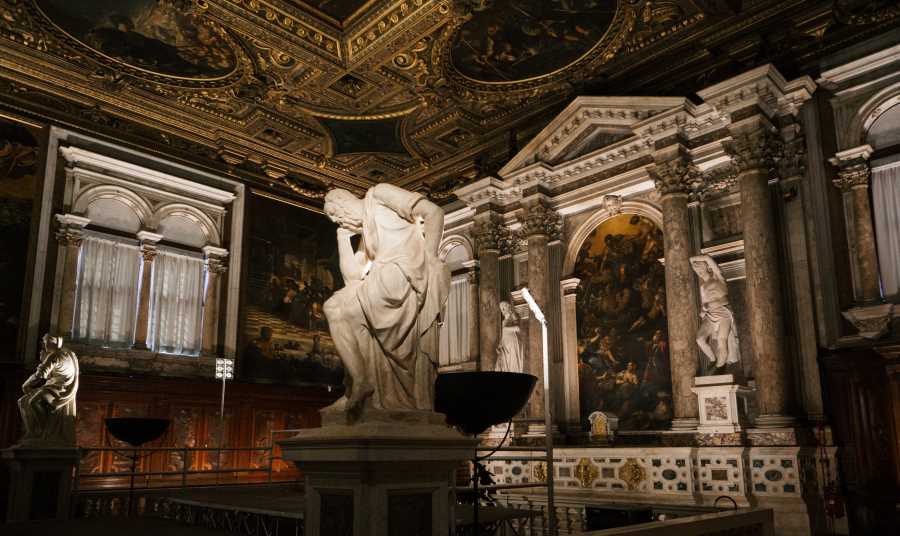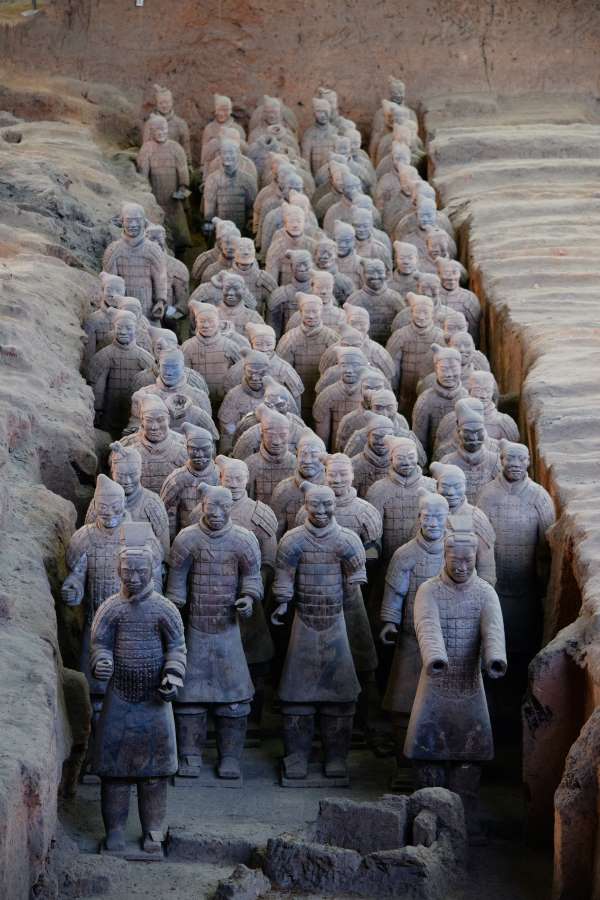Artists throughout the ages had different relationships with the concepts of mortality and immortality, depending on the historical context they were immersed in and on cultural values and environmental factors. In this article, we will try to analyze how artists chronologically responded to the fear of disappearing through the power of art, according to their historical period.
The Greek conceptions of death and the eternity of sculptures
In Ancient Greece, humans were in contact with death on a daily basis, and when it wasn’t wars and battles that made them think about death, they were constantly reminded of it in their leisure time, often staging grim theatrical performances and assisting at cruel competitions and fights. The Greeks were indeed the illuminated people who invented philosophy, aesthetics, democracy, but they also had a macabre taste for violence and tragedy which would be unacceptable in our culture today.
Nowadays, the fear of what will happen after biological life induces us to try to escape death, mourning and suffering, as death is greatly repressed in our society, whereas in Ancient Greece, thinking about mortality and representing it through art, theatre, poetry, was seen as normal. According to the Greeks, the fear of death does not have an equally paralyzing effect on all men; on the contrary warriors, suicide bombers, athletes, do not shy away from it but face it, even in circumstances that appear as unreasonable in our eyes.
But why did the Greeks have such a different perspective from us? Cowardice or mythical heroism did not play a role here, the idea of death in Ancient Greece was mitigated by the confident concept of immortality. Greeks strongly believed in the immortality of the soul (psyche), conceived as a little breath which would leave the body at the moment of death. The terror of existence was accompanied by the certainty of plausible immortality and a life of concern was philosophically and epicureanally discouraged. The best solution was to ‘live, without the fear of dying’.
What is really interesting is that in Ancient Greece this concept of immortality, so intertwined with life and body, also permeated art. Mourning is a frequent iconography in Greek art, and the afterlife and the ceremonies associated with burial are attested by several artefacts. However, it is in sculpture that the concept of immortality is particularly glaring. Hellenistic sculpture was an explicit attempt to immortalize the human body through the ideal of beauty and perfection. Sculptures like the “Seated Boxer”, an old boxer who has probably lost his fight, eternalizes human pain, sorrow and failure, while creating something imperishable. The boxer lost the fight with life, but not with eternity; the defeat of the body, the limits of biology, does not signify the defeat of the soul, on the contrary, it transcends corporeality. Hellenistic sculpture confirmed how immortality of the soul and mortality of the body could coexist. Greek statues explicitly idealized the shapes of the human body, in order to save them from the decay of the flesh, and they accomplished this by using durable mediums such as bronze and marble.
The medieval fear of death and its parables
Plagues, death and pandemics were the first problems that Medieval human beings had to endure, especially in the 13th and 14th century. The fear of this macabre presence in everyday life, their encounter with grief and guilt, also left traces in their art, impacting iconographies, color palettes – which became gloomy and darker – atmospheres and subjects. The art critic Johan Huizinga stated that during the end of the Middle Ages the ancient admonition of the memento mori, the classical reminder of the transience of life, had become ‘’a mournful chorus echoing everywhere”.
This collective and universal anxiety about death was also perpetrated by Christian religion at the time, which suggested penitence, sacrifices, expiations, and incited the threat of a terrible and eternal damnation. Medieval men and women could not avoid death, so they devised a way to live with it, through art and symbolic representation. Subjects such as the decay of bodily beauty and the fading of youth were very common in the art of that era, as was the grisly subject of the ‘dance of death’, a funeral procession of skeletons marching, reminding us of the fate shared by all human beings.
The corruptibility of the human body was an obsession in the Middle Ages and there was no belief in an afterlife that was not populated by monsters and terrible presences. Therefore, the theme of immortality was never associated with the caducity of the body and it was always represented in a very literal way, with deceased skeletons and physical decay. An example of this mental attitude reflected in visual culture is the parable of the ‘Three Living and Three Dead’, depicted in several miniatures and frescoes. In this motif, three noblemen are symmetrically faced with three skeletons, alluding to their imminent death. The scene was intended to act as an elaborate memento mori. Medieval miniatures were not only a reminder of the universality of life’s end but they also wanted to raise awareness on the ephemeral nature of earthly pleasures. Medieval men and women praised living life, the here and now, because they were terrified of the future.
The Renaissance and the immortality of portraiture
With the advent of the Renaissance and particularly with the spread of current Humanistic thinking, the relationship between human beings, death and the afterlife changed once again. Renaissance men and women abandoned the obscurantism of religion and morality, and put themselves back at the centre of their own life, rediscovering those joys of earthly life that had been demonised in previous centuries. The Renaissance was a cultural shift where people emerged from existential anguish and reappropriated human vitality and life on earth, mostly because “nel doman non v’è certezza”, of tomorrow there is no certainty.
The word vitality is emblematic in this discourse about life, death and the afterlife. Renaissance art dealt with the theme of immortality by trying to make human beings live forever, but on earth, not otherworldly. It expressed the vital part and the peculiar characteristics of human beings. In this sense, the genre of portraiture was the most widely used. In the early Renaissance we witnessed the flourishing of commemorative portraits, already used in classical Roman times, through effigies. Memorial portraits had the substantial function to survive the soul of the beloved or illustrious protagonist when deceased, and to make his deeds and virtues eternal. However, there are Renaissance portraits that went beyond this commemorative and celebrative function, and they are those of Leonardo da Vinci.
Da Vinci’s portraits are special because they tried to immortalize, in an extremely realistic manner, not only the aspect of the sitter but also their attitude, psychological traits, their “motions of the mind”. These paintings are not merely a fact of naturalism. Da Vinci conducted scientific research on the anatomy and physiology of his sitters in order to represent their psychological traits, their inclination of the soul, their emotions and personality. He explored how the body and the soul of human beings react to each other, valorizing humankind, and conceived as something with individual reactions and unrepeatable.
This humanistic idea clearly made an impact on the way we perceive Renaissance art and its relationship with immortality. Da Vinci’s iconic Mona Lisa, Belle Ferronnière, Lady with an Ermine, were not just intense and well-known portraits, they literally changed the representation of this genre because the protagonists seemed to have an “inner life” which was eternalized forever. They escaped the aging process because they embodied something more ideal and spiritual: a universal archetype of feminine temperament.
Il Musico (Portrait of a Musician), one of the few male portraits by Leonardo da Vinci, also dealt with the concept of eternity and mortality. In fact, the protagonist is carrying a sheet of music, an attribute that could probably represent his lifetime profession but also his soul. Hence, this cartellino can be interpreted as a symbol of vanitas, a reminder of the ephemeral nature of life; a music composition is powerful, but sooner or later it ends, it’s ephemeral. However, Da Vinci stated, the medium of painting is eternal; thereby, the Renaissance genius transformed this symbol into a statement about the immortality of the portrayed, but synecdochally, about the immortality of the genre of the portrait, too.
Once again, art is considered one the most impressive instruments to have reached eternity.
In the following article, which constitutes Part II of this series, you can read more about the periods of 17th century Dutch still life painting and the concept of vanitas, death and immortality in the 20th century avant-gardes and contemporary perspectives and dilemmas.
Aby Warburg (1902): The Art of Portraiture and the Florentine Bourgeoisie.
Zöllner, Frank (2005): “The “Motions of the Mind” in Renaissance Portraits: The Spiritual Dimension of Portraiture”, Zeitschrift für Kunstgeschichte, 68. Bd., H. 1, pp.23-40.
Brown, David Alan (1983): “Leonardo and the Idealized Portrait in Milan”, in Arte Lombarda, Nuova Serie, No. 67 (4), Atti del Convegno: Umanesimo problemi aperti 8, pp.102-116.
Fugelso, Karl (2010): “Music as Im(mortality) in Leonardo’s Portrait of a Man”, in Notes in the History of Art, Vol. 30, No. 1, pp.24-28.















